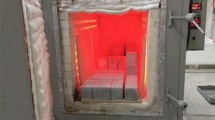Abstract
The microstructural characteristics of high performance concrete (HPC) samples were analysed using scanning electronic microscopy (SEM) and X-ray diffraction (XRD) following thermo-hydraulic and thermo-mechanical testing. The relationship between engineering behaviour (transport and mechanical properties) and microstructure for HPC was then analysed. The failure mechanism of HPC under thermo-mechanical conditions was also discussed. Lower porosity, a higher content of calcium silicate hydrate (C−S−H) and a lower content of the crystalline-phase calcium hydroxide (CH) in both the cement paste and transition zone all exerted a positive influence on the transport and mechanical properties of HPC. By increasing temperature to 200°C, the evaporation of water led to an increase in capillary porosity as well as to a reduction in the cohesive forces between C−S−H layers, which cause degradation of the concrete’s transport and mechanical properties. Microcracking under thermo-mechanical conditions proved to be the main failure mechanism of HPC.
Résumé
Les propriétés microstructurelles des échantillons de béton à haute performance (BHP) ont été analysées par microscopie électronique à balayage (MEB) et diffraction X, suite aux tests thermo-hydrauliques et thermo-mécaniques. Les relations entre le comportement en matière d’ingénierie du matériau (propriétés mécaniques et de transfert) et les microstructures de BHP ont été ensuite évaluées. Le mécanisme de rupture du BHP sous des conditions thermo-mécaniques a aussi été abordé dans ce papier. Un niveau de porosité plus faible, une plus grande concentration en silicate de calcium hydraté (C−H−S) et une concentration plus faible de l’hydroxyde de calcium (CH) à la fois dans la pâte de ciment et dans la zone de transition ont joué une influence positive sur les propriétés mécaniques et de transfert des BHP. En élevant la T° à 200°C, l’évaporation de l’eau a conduit à une augmentation de la porosité capillaire de même qu’à une réduction des forces de cohésion entre les couches de H−S−C, engendrant une dégradation des propriétés mécaniques et de transfert du béton. Les microfissures sous l’effet des conditions thermo-mécaniques se sont avérées être la cause principale de dégradation mécanique du BHP.
Similar content being viewed by others
References
Onofrei, M., ‘Evaluation of the long-term durability of high-performance cement-based grouts’, Ph-D Thesis. (Université de Sherbrooke, Département du génie civil, 1996).
Mehta, P. K., Monterio, P. J. M., ‘Concrete-structure, properties and materials’, 2nd Edn., (Prentice Inc., Englewood Cliffs, NJ, 1993).
Li, X. H. ‘Engineering behavior of special concrete liner at variable pressure and temperature conditions. Ph-D Thesis, (Université de Sherbrooke, Department du geme civil, 1999).
Hertz, K. ‘Heat-induced explosion of dense concrete’, Research Report. No. 166, (Institute of Building Design, Technical University of Denmark, Lyngby, 1984).
Buscheck, T. A. and Nitao, J. J., ‘Repository heat, driven hydrothermal flow at Yucca mountain, Part I: Modeling and analysis’, in Proceedings of the Fourth Int. High Level Radioactive Waste Management Conf., Las Vegas, NV, (1993) 418–448.
Licastro, P. H., Fernandez, J. A. and Roy, D. M., ‘Preliminary laboratory testing of selected cementitious material for the Yucca mountain project repository sealing program. Sandia Report, Sand 86-0558. (Sandia National laboratories, Albuquerque, 1990).
Palardy D., Onofrei, M. and Ballivy, G. ‘Microstructural changes due to elevated temperature in cement-based grouts’, Presented in Material Research Society 1995 fall Meeting, Boston, 1995 (Material Research Society, 1995).
Roy, D. M., Grutzeck, M. W. and Licastro, P. H., ‘Evaluation of cement Borehole-plug longevity’, Technical Report, ONWI-30. (Materials Research laboratory, The Pennsyvania State University, 1979).
Weiming, L., Lin, T. D. and Powers-Couche L. J., ‘Microstructures of fire-damaged concrete,’ACI Materials Journal 93 (3), (1996) 199–205.
Cohen, M. D. and Klistikas, ‘Mechanisms of hydration and strength developments in Portland cement composites containing silica fume particles’,Indian Concrete Journal (1986), 296–300.
Aircin, P. C., Sarkar, S. L. and Diatta, Y., ‘Microstructural study of different types of very-high-strength concrete’, Materials Research Society Symposium Proceedings, V. 86. Materials Research Society, Pittsburgh, (1987), 261–272.
Ghosh, S. and Nasser, K. W., ‘Effects of high temperature and pressure on strength and elasticity of lignite fly ash and silica fume concrete,’ACI Materials Journal 93 (1), (1996), 51–60.
Jensen, B. C. and Arrup, B., ‘Fire resistance of fibre reinforced silica fume based concrete’, in Proceedings of the 4th International Symposium on Utilization of High-Strength/High-performance Concrete, Parise, (1996), 551–559.
Author information
Authors and Affiliations
Additional information
Editorial Note. Prof. Z. Li is a RILEM Senior Member. Prof. G. Ballivy and Prof. K. Khayat work at the CRIB—University of Sherbrooke, a RILEM Titular Member.
Rights and permissions
About this article
Cite this article
Li, X.J., Li, Z.J., Onofrei, M. et al. Microstructural characteristics of HPC under different thermo-mechanical and thermo-hydraulic conditions. Mater Struct 32, 727–733 (1999). https://doi.org/10.1007/BF02905069
Received:
Accepted:
Issue Date:
DOI: https://doi.org/10.1007/BF02905069




